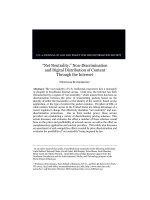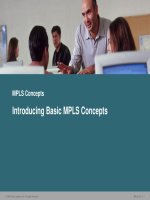Computers and digital basic computer concepts 2014 chapter06 ZC
Bạn đang xem bản rút gọn của tài liệu. Xem và tải ngay bản đầy đủ của tài liệu tại đây (3.88 MB, 63 trang )
Chapter 6
The Internet
Computer Concepts 2014
6 Chapter Contents
Section A: Internet Technology
Section B: Fixed Internet Access
Section C: Portable and Mobile Internet
Section D: Internet Services
Section E: Internet Security
Chapter 6: The Internet
Access
2
6 FastPoll True/False Questions
Answer A for True and B for False
060200 TCP, IP, UDP, HTTP, and FTP are examples
of protocols used on the Internet.
060300 204.127.129.100 is an example of an IP
address.
060400 .edu and .ca are examples of top-level
domains.
060500 The Domain Name System stores IP
addresses and their equivalent domain names.
Chapter 6: The Internet
3
6 FastPoll True/False Questions
Answer A for True and B for False
060600 Utilities such as Ping and Traceroute help
you gauge the speed of your Internet connection.
060700 10 Mbps is a narrowband Internet
connection.
060800 Dial-up and DSL provide Internet access
using telephone cabling.
060900 Cable Internet service is fast because it has
lots of latency.
061000 WiMAX uses low-earth orbiting satellites to
transport data to the Internet.
Chapter 6: The Internet
4
6 FastPoll True/False Questions
Answer A for True and B for False
061100 Public Wi-Fi hotspots provide mobile
Internet access.
061200 With mobile broadband, you can use a cell
phone to set up a mobile Internet connection.
061300 Cloud computing uses distributed grid
computing to predict weather.
061400 VoIP uses circuit switching technology to
send analog data.
061500 SETI@home is a popular Wi-Fi service
provider for non-business consumers.
Chapter 6: The Internet
5
Section
A:
Internet
6
Technology
Background
Internet Infrastructure
Internet Protocols, Addresses, and Domains
Connection Speed
Chapter 6: The Internet
6
6 Background
The ARPANET, created in 1969,
connected computers at UCLA,
Stanford Research Institute,
University of Utah, and University
of California at Santa Barbara
Early Internet pioneers used
primitive command-line user
interfaces to send e-mail,
transfer files, and run scientific
calculations on Internet
supercomputers
With an estimated 500 million
nodes and more than 2 billion
users, the Internet is huge
Chapter 6: The Internet
7
6 Internet Infrastructure
The Internet is not owned or operated by any single
corporation or government
The Internet backbone is a network of high-capacity routers
and fiber-optic communications links that provides the main
routes for data traffic across the Internet
Backbone links and routers are maintained by network
service providers (NSPs)
NSP equipment and links are tied together by network
access points (NAPs)
An Internet service provider (ISP) is a company that offers
Internet access to individuals, businesses, and smaller ISPs
Chapter 6: The Internet
8
6 Internet Infrastructure
Chapter 6: The Internet
9
6 Internet Infrastructure
To communicate with an ISP, your computer
uses some type of communications device, such
as a modem
Chapter 6: The Internet
10
Internet
Protocols,
6
Addresses, and Domains
A computer can have a permanently assigned
static IP address or a temporarily assigned
dynamic IP address
Chapter 6: The Internet
11
Internet
Protocols,
6
Addresses, and Domains
A domain name is a key component of Web
page addresses and e-mail addresses
Chapter 6: The Internet
12
Internet
Protocols,
6
Addresses, and Domains
Chapter 6: The Internet
13
Internet
Protocols,
6
Addresses, and Domains
Chapter 6: The Internet
14
Internet
Protocols,
6
Addresses, and Domains
Chapter 6: The Internet
15
6 Connection Speed
Data travels over the Internet at an incredible speed
The elapsed time for data to make a round trip from
point A to point B and back to point A is referred to
as latency
Ping
Traceroute
Upstream vs. downstream speed
Chapter 6: The Internet
16
6 Connection Speed
Chapter 6: The Internet
17
6 Connection Speed
When upstream speeds differ from downstream
speeds, you have an asymmetric Internet
connection
When upstream and downstream speeds are the
same, you have a symmetric Internet connection
Internet connection options
Fixed Internet access
Portable Internet access
Mobile Internet access
Chapter 6: The Internet
18
6 Connection Speed
Chapter 6: The Internet
19
Section
B:
Fixed
Internet
6
Access
Dial-up Connections
DSL
Cable Internet Service
Satellite Internet Service
Fixed Wireless Service
Fixed Internet Connection Roundup
Chapter 6: The Internet
20
6 Question
062200 Although ISPs offer Internet access though
dial-up, satellites, WiMAX, and DSL, cable Internet
is currently the preferred access method. Why?
A. It is the least expensive.
B. It is the fastest and most widely available
technology.
C. It has the highest latency.
D. It was the original Internet access technology.
Chapter 6: The Internet
21
6 Dial-up Connections
A dial-up connection is a fixed Internet connection
that uses a voiceband modem and telephone lines
to transport data between your computer and your
ISP
Chapter 6: The Internet
22
6 Dial-up Connections
A voiceband modem converts the signals from your
computer into audible analog signals that can travel
over telephone lines
Modem speed is measured in bits per second
Chapter 6: The Internet
23
6 DSL
DSL is a high-speed, digital, always-on Internet
access technology that runs over standard phone
lines
The speed of a DSL connection varies
DSL modem
DSL filter
Chapter 6: The Internet
24
6 DSL
Chapter 6: The Internet
25









